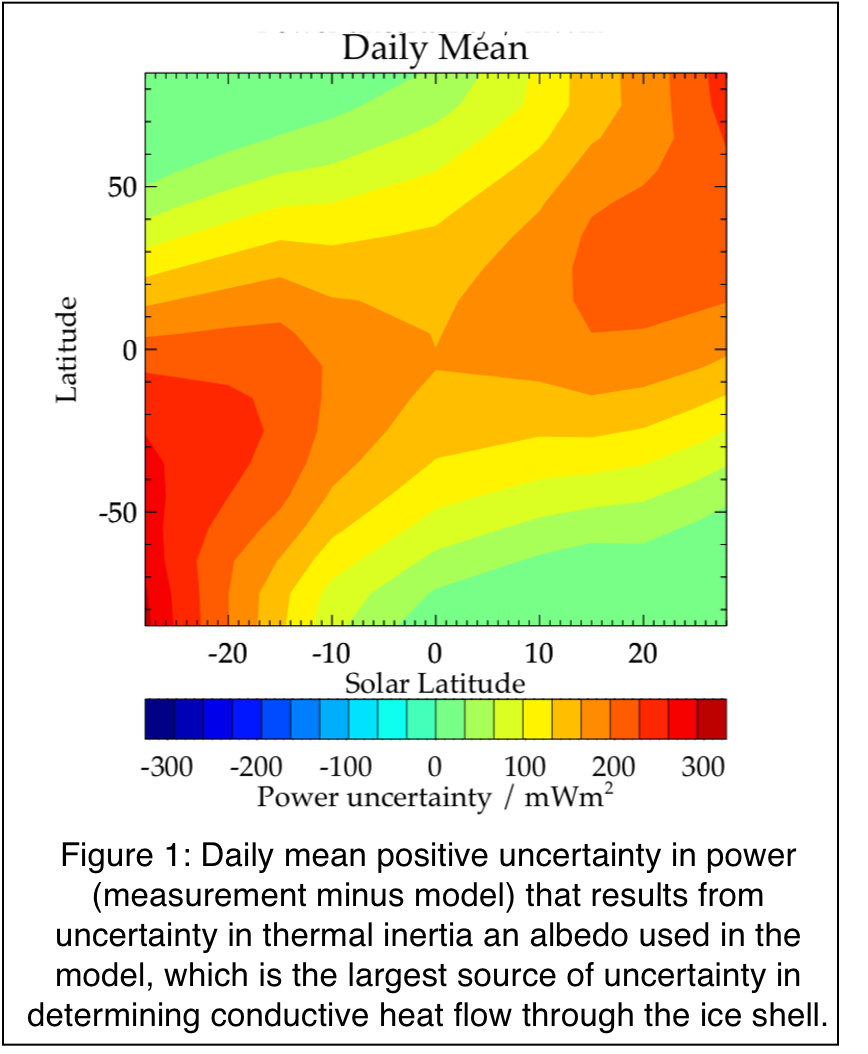- 1Southwest Research Institute, Boulder Affiliate, Cambridge, UK (georgina.miles@boulder.swri.edu)
- 2University of Oxford, UK
- 3Planetary Science Institute, USA
With new missions (Juice, Europa Clipper) to icy worlds in the outer solar system in the near future, the structure, composition and evolution of these bodies is highly relevant. Enceladus is Saturn’s brightest moon, with an icy shell predominately made of water ice and a subsurface salty ocean. This is principally maintained by energy dissipation due to its orbit around Saturn. It is cryo-volcanically active in the South Polar Terrain (SPT), a region observed to be significantly warmer than the rest of the surface - acutely so in the ‘Tiger Stripes’ at the south pole from whence sub-surface material is ejected onto the surface and into space. We care about measuring emitted power because the energy budget of Enceladus directly pertains to theories of the evolution of Saturn’s moons and the longevity of the subsurface ocean. Current estimates of the endogenic heat at Enceladus’ active SPT region are between 4 and 19 GW or 100-500 mWm-2 [1,2].
Lower intensity (background) endogenic heat conducted through the ice shell is more challenging to distinguish from passive, re-radiated emission. Yet, because it occurs over the entire surface the total heat loss is expected to be significant for Enceladus’ total energy budget (modelled to be 25-150 GW or 2.3 - 187 mWm-2 [3,4]). We consider the theoretical and functional limits to the detection of potential endogenic heat on Enceladus outside the SPT using observations from Cassini’s Composition InfraRed Spectrometer (CIRS) and a surface thermal model.
The range of thermal inertia and bolometric albedos of Enceladus were derived from a selection of CIRS observations [5]. These values are used to model expected surface temperature. The uncertainty in thermal properties can be used to assign an upper limit to temperature (or power) differences between observed and model temperatures that could be explained by these uncertainties. Scenes warmer than this threshold value could indicate endogenic thermal emission. We model this minimum detection limit that varies with time of day, latitude, longitude and consequently temperature – because emitting power for a given temperature change is itself strongly temperature dependent.
Figure 1 shows the maximum excess power (observation minus model) that can be due to model uncertainty for a full range of solar latitudes (half of a Saturn year) at all latitudes for passive emission. It is shown here as a daily average at 0° longitude but changes with diurnally varying surface temperature and longitude. This work shows that if averaged conductive heat flow is less than the values given in this figure, it would not be detectable by remote sensing due to current uncertainty in thermal properties. It also highlights that the optimum conditions for detecting endogenic heat are at night or in polar winter – in the coldest scenes with no insolation. These are conditions where observation error increases due to the noise quotient. At the coldest temperatures, observations can be averaged to minimize observation uncertainty.
We will present findings to show that even with the current range of uncertainty in thermal inertia and albedo it may be possible to detect excess endogenic power as low as 20 mWm-2 in the coldest scenes, or 40 mWm-2 at mid-latitudes provided there are suitable observations. When we compare these limits with observed measurement minus model differences from CIRS, this can also infer a cap to the possible conductive heat flow. We expect that the upper limit of the model estimate given by [4] is unlikely. If an excess power of 187 mWm-2 were present it would be readily apparent from CIRS observations when confronted with modelled temperatures.
Quantifying Enceladus’ endogenic heat budget and imposing observation-based constraints to models of conductive heat flow would greatly enhance our understanding of the evolution of Enceladus (and by consequence all of Saturn’s moons). While this approach is ultimately limited by model uncertainties in the thermal properties of Enceladus’ surface, this is an observation limitation that can be improved. The thermal inertia and albedo derivation from CIRS data by [5] is in the process of being extended to use data from the full mission. This would be greatly enhanced by more detailed thermal observations at many local times and over as much as the Saturn year as possible – particularly in the polar regions. Since it is very challenging to observe these locations from Earth, orbiting instruments with high inclination would be welcomed to more accurately characterise the thermal properties of these icy moons and thus understand their evolution.

[1] C. J. A. Howett, J. R. Spencer, J. Pearl, and M. Segura, “High heat flow from Enceladus’ south polar region measured using 10-600 cm-1 Cassini/CIRS data,” Journal of Geophysical Research E: Planets, vol. 116, no. 3, 2011, doi: 10.1029/2010JE003718.
[2] J. Spencer et al., “Plume Origins and Plumbing (Ocean to Surface),” in Enceladus and the Icy Moons of Saturn, P. M. Schenk, R. N. Clark, C. J. A. Howett, A. J. Verbiscer, and J. H. Waite, Eds., The University of Arizona Press, 2018, pp. 163–174. doi: 10.2458/azu_uapress_9780816537075-ch008.
[3] V. Lainey et al., “Resonance locking in giant planets indicated by the rapid orbital expansion of Titan,” Nat Astron, vol. 4, no. 11, pp. 1053–1058, Nov. 2020, doi: 10.1038/s41550-020-1120-5.
[4] D. J. Hemingway and T. Mittal, “Enceladus’s ice shell structure as a window on internal heat production,” Icarus, vol. 332, pp. 111–131, Nov. 2019, doi: 10.1016/j.icarus.2019.03.011.
[5] C. J. A. Howett, J. R. Spencer, J. Pearl, and M. Segura, “Thermal inertia and bolometric Bond albedo values for Mimas, Enceladus, Tethys, Dione, Rhea and Iapetus as derived from Cassini/CIRS measurements,” Icarus, vol. 206, no. 2, pp. 573–593, Apr. 2010, doi: 10.1016/j.icarus.2009.07.016.
How to cite: Miles, G., Howett, C., and Spencer, J.: Establishing limits to endogenic heat detection on Enceladus, Europlanet Science Congress 2024, Berlin, Germany, 8–13 Sep 2024, EPSC2024-1044, https://doi.org/10.5194/epsc2024-1044, 2024.